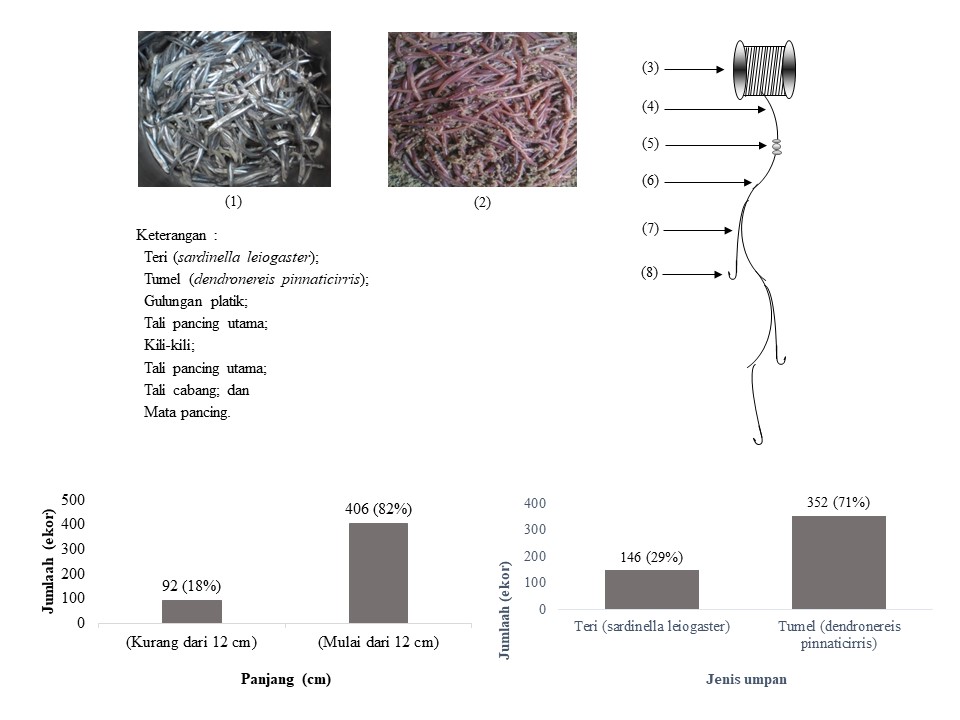The Influence of Types of Fishing Handline Catches of Kurisi Fish (Nemipterus nematophorus)
DOI:
https://doi.org/10.46252/jsai-fpik-unipa.2020.Vol.4.No.2.110Keywords:
kurisi, bait types, anchovy, tumel, handline, watdekAbstract
The fishing of kurisi fish (nemipterus nematophorus) using handline in Watdek waters Southeast Maluku district in November 2019. Types of anchovy bait (sardinella leiogaster) and tumel (dendronereis pinnaticirris) are used to catch kurisi fish. The fishing time is divided into two, namely at 07.00 – 10.00 a.m and at 14.00 – 17 p.m. The method used is a comparative descriptive analysis method to see the difference in the time of catching kurisi fish to the catching result and statistical analysis of a completely randomized design (CRD) to see the influence of the bait on the number of catching result. The total number of kurisi fish caught was 498. Tumel bait gets the most catches, 352 (71%), while anchovy bait only get 146 fish (29%). The most effective time for catching kurisi fish is at 07.00 a.m – 10.00 a.m, getting 349 fish (74%) and at 14.00 – 17.00 p.m get 123 fish (26%).
Downloads
References
CAFS, (2006). Ikan ikan kurisi (Nemipterus nematophorus). [internet]. [diunduh 2019 Desember 05]. Tersedia pada https://www.fishbase.se/photos/PicturesSummary.php?ID=4558&what=species
Elhaweet, A.EA. (2013). Biological studies of the invasive species Nemipterus japonicus (Bloch, 1791) as a Red Sea Immigrant into the Meditteranian. Egyptian Journal of Aquatic Research, 39: 267-274.
Farikha, K., Pramonowibowo., Asriyanto, (2014). Pengaruh Perbedaan Bentuk Dan Warna Umpan Tiruan Terhadap Hasil Tangkapan Gurita Pada Alat Tangkap Pancing Ulur Di Perairan Baron, Gunung Kidul. Journal of Fisheries Resources Utilization Management and Technology, 3(3): 275-283.
Fitriyana, M.F., Zulkarnain1., Yusfiandayani, R., dan Izza Mahdiana Apriliani, I.M. (2018). Penggunaan Cacing Tanah (Lumbricus Rubellus) Sebagai Umpan Alternatif Pada Pancing Ulur Yang Dioperasikan Malam Hari Di Teluk Palabuhanratu. Jurnal Akuatika Indonesia 3(2): 119-126
Hukom, F.D., Dody, S., Peritiwadi, T., Malikusworo, H., Hermana, I.D., Omar, S.B. (2004). Penelitian Sumberdaya Perikanan Kakap Laut Dalam (Sub Family Etelinae) di Selat Makasar dan Laut Sulawesi. Jakarta: Pusat Penelitian Oseanografi-LIPI.
Manojkumar, P.P. (2004). Some aspects on the biology of Nemipterusjaponicus (Bloch) from Veraval in Gujarat. Indian J. Fish, 51(2):185-191
Oktaviyani, S. (2014). Karakteristik Morfologi Dan Aspek Biologi Ikan Kurisi, Oseana, 36(4):29-34
Rahaningmas, J.M., Mansyur, A. (2018). Pengaruh Perbedaan Jenis Umpan Terhadap Hasil Tangkapan Ikan Kakatua (Famili: Scaridae) Menggunakan Pancing Ulur. Jurnal Sumberdaya Akuatik Indopasifik, 2(1): 25-34
Saisar, F., Zulkarnain., Mawardi, W., Purwangka, F., Izza Mahdiana Apriliani, I.M. (2019). Cacing Tanah (Lumbricus rubellus) Sebagai Umpan Alternatif Dan Karakteristik Kesukaan Ikan Hasil Tangkapan Pancing Ulur (Hand line) di Perairan Teluk Palabuhanratu. Albacore, 3(3):283-296
Saputra, D.O., Zulkarnain1., Fis Purwangka, F., Apriliani, I.M., (2018). Penggunaan Umpan Cacing Wak-Wak (Xenosiphon Sp.) Pada Pancing Ulur Yang Dioperasikan Siang Hari Di Kecamatan Manggar Pulau Belitung. Jurnal Akuatika Indonesia, 3(2):110-118, https://doi.org/10.24198/jaki.v3i2.23397
Sjafei, D.S., Robiyani. (2001). Kebiasaan Makanan Dan Faktor Kondisi Ikan Kurisi, Di Perairan Teluk Labuan, Banten. Jurnal Iktiologi Indonesia, 1(1):7-11
Wahyuni, I.S., Hartati, S.T., Indarsyah, I.J. (2009). Informasi biologi perikanan ikan kurisi di Blanakan dan Tegal. Bawal, 2(4):171-176.



















